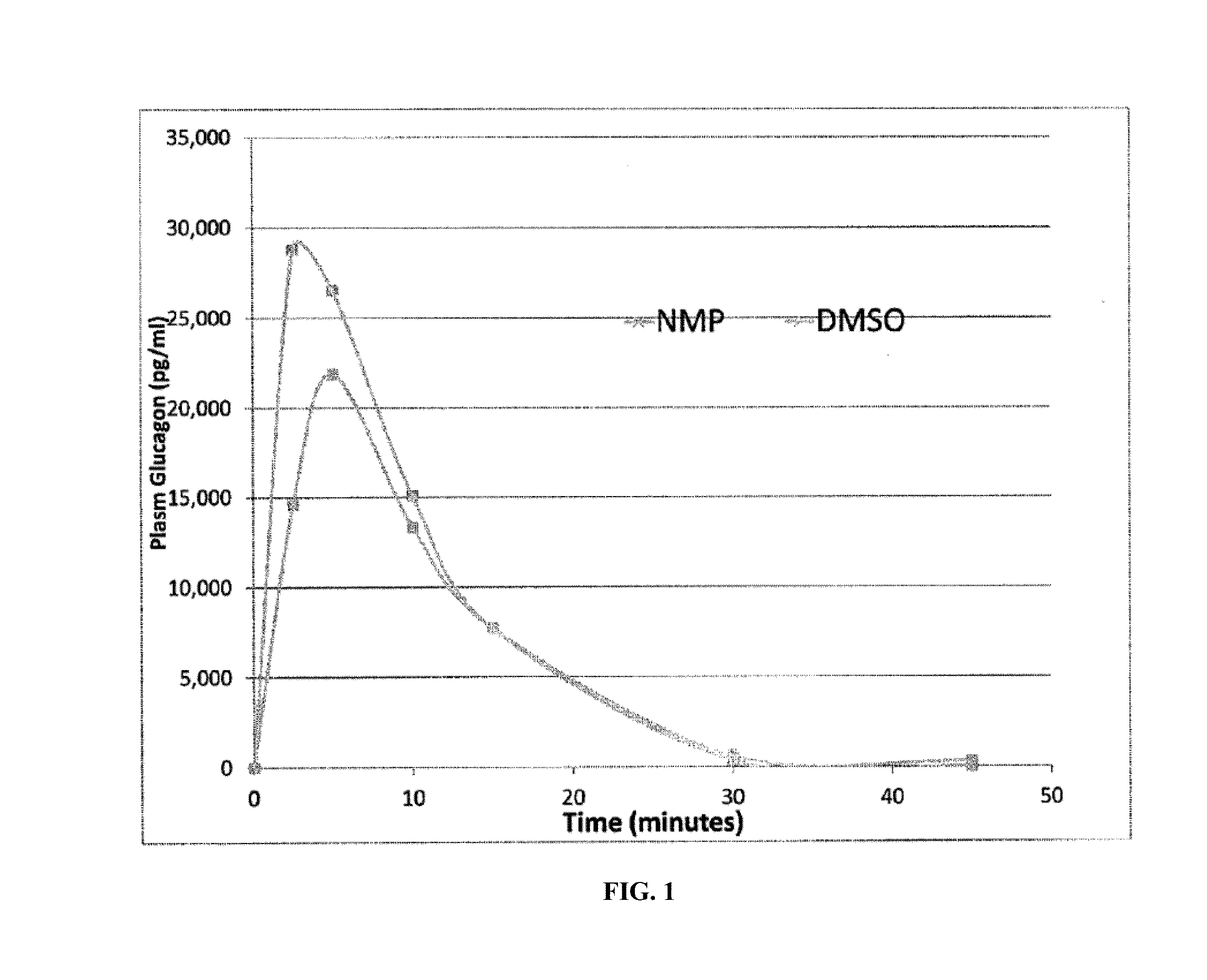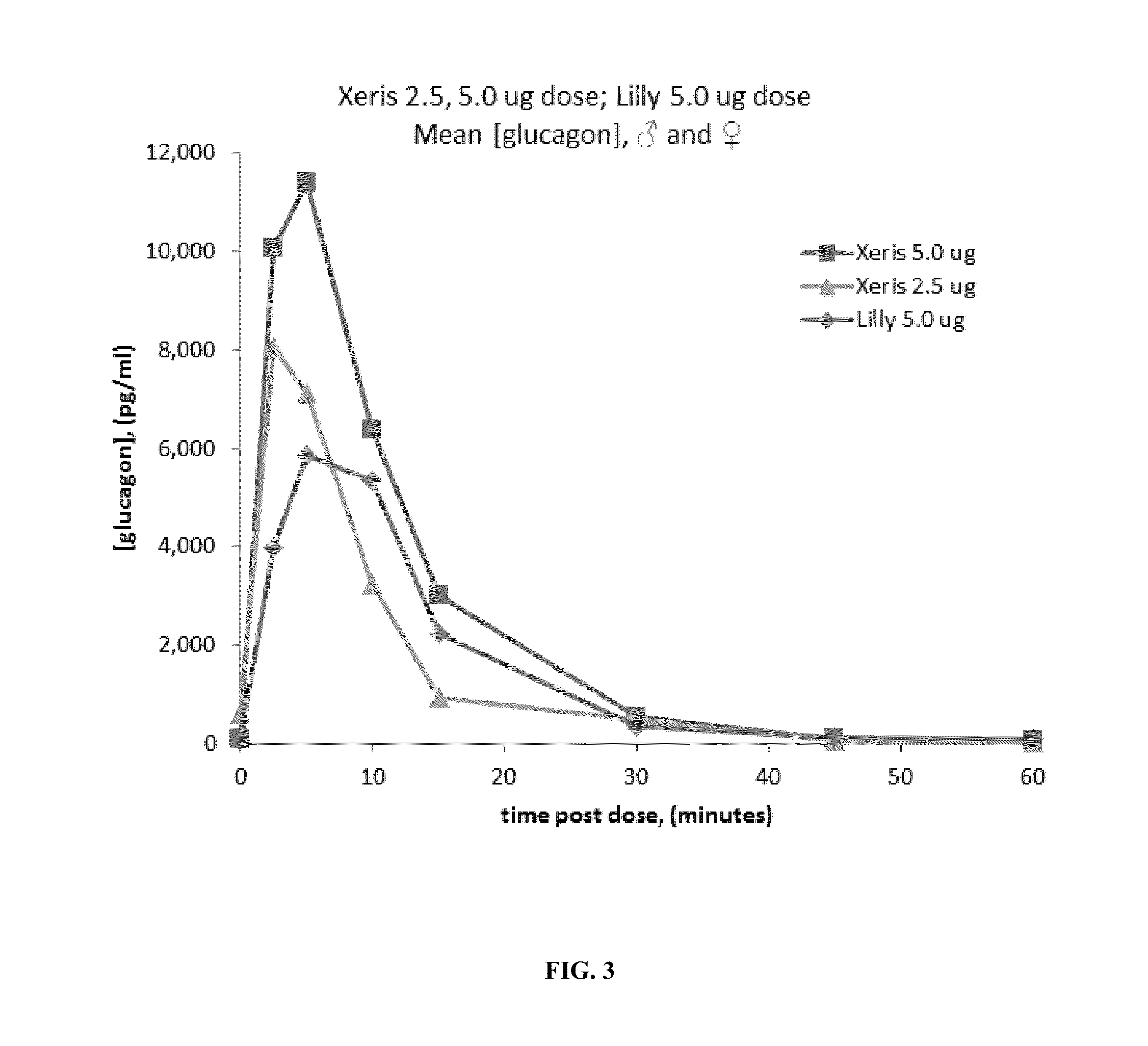Methods for rapidly treating severe hypoglycemia
a technology of severe hypoglycemia and rapid treatment, applied in the direction of peptide/protein ingredients, extracellular fluid disorder, metabolic disorder, etc., can solve the problems of imminent severe hypoglycemia or severe hypoglycemia
- Summary
- Abstract
- Description
- Claims
- Application Information
AI Technical Summary
Benefits of technology
Problems solved by technology
Method used
Image
Examples
example 1
Preparation of Glucagon Solutions for Use in Freeze-Drying
[0120]Various solutions were prepared to contain glucagon at a concentration of 10 mg / mL. The solutions contained, alternatively, glycine, citrate or phosphate at 5 mM, generally providing a buffer establishing a pH of 3. The solution also contained a sugar, alone or in combination, in amounts equal to the w / v amount of glucagon (1:1) or at 200% (2:1) of the amount of glucagon. The sugars were trehalose, HES, and .beta.-cyclodextrin (β-CD). Some solutions also contained Tween-20 at 0.10% w / v as a surfactant. The various formulations were mixed to substantial homogeneity in amounts as described in Table 1 below.
TABLE 1Glucagon Mixtures for Subsequent LyophilizationGlycineCitratePhosphateGlucagonBufferBufferBufferTrehaloseHESβ-CDTween-20Formulation #(mg / ml)(mM)(mM)(mM)(mg / ml)(mg / ml)(mg / ml)(mg / ml)155000000255000000.01355001000045500010005550055006550000100750500000850500000.0195050100001050500100011505055001250500010013500500001...
example 2
Preparation of Dry Glucagon Powder by Freeze-Drying
[0122]The above formulations of Table 1 were pipetted (0.3 mL) into 3-mL lyophilization vials (13-mm ID). The formulations were lyophilized in a FTS Durastop freeze-drier (Stoneridge, N.Y.). Samples were frozen at −40° C. at a ramp of 2.5° C. / min and maintained for 2 hours (h) to allow sufficient freezing. The sample temperature was then increased to −5° C. at a ramp of 2° C. / min and held for 2 h as an annealing step. The temperature was then decreased to 30° C. at a ramp of 1.5° C. / min and the vacuum was turned on at 60 mTorr. The primary drying was set for 24 h. The temperature was gradually increased to 40° C. at a ramp of 0.5° C. / min and held for additional 10 h. After drying was complete, the vials were capped under vacuum using XX stoppers from the West Pharmaceutical company (product #10123524). None of the formulations showed any evidence of cake collapse following freeze-drying. The moisture content of the final dried produ...
example 3
Preparation of Glucagon Formulations in Aprotic Polar Solvents
[0123]Six of the dry powders made from the solutions in Table 1 were selected for formulation in polar, aprotic solvents: [0131] 1. Buffer (glycine)+trehalose (200% relative to glucagon) (formulation #3) [0132] 2. Buffer (glycine)+HES (200% relative to glucagon) (formulation #4) [0133] 3. Buffer (glycine)+trehalose (100% relative to glucagon)+HES (100% relative to glucagon) (formulation #5) [0134] 4. Buffer (glycine)+Tween-20 (0.01% w / v)+trehalose (200% relative to glucagon) (formulation #19) [0135] 5. Buffer (glycine)+Tween-20 (0.01% w / v)+HES (200% relative to glucagon) (formulation #20) [0136] 6. Buffer (glycine)+Tween-20 (0.01% w / v)+trehalose (100% relative to glucagon)+HES (100% relative to glucagon) (formulation #21)
PUM
 Login to View More
Login to View More Abstract
Description
Claims
Application Information
 Login to View More
Login to View More - R&D
- Intellectual Property
- Life Sciences
- Materials
- Tech Scout
- Unparalleled Data Quality
- Higher Quality Content
- 60% Fewer Hallucinations
Browse by: Latest US Patents, China's latest patents, Technical Efficacy Thesaurus, Application Domain, Technology Topic, Popular Technical Reports.
© 2025 PatSnap. All rights reserved.Legal|Privacy policy|Modern Slavery Act Transparency Statement|Sitemap|About US| Contact US: help@patsnap.com



